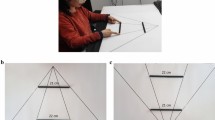Abstract
Subjects (n=12) grasped mirror-viewed visual targets with thumb and index finger, while prescribed movement time differed between blocks of trials. The variability of both final grip aperture (i.e. distance between thumb and index finger) and of final wrist position increased with decreasing movement time, indicating the existence of a speed-accuracy tradeoff both in the grasp and in the transport component of prehension. This tradeoff was limited to relatively short movement times (<400 ms) for the grasp component, but it extended to longer movement times for the transport component, which supports the view that the two components are controlled by separate mechanisms.





Similar content being viewed by others
References
Bootsma RJ, Marteniuk RG, MacKenzie CL, Zaal FT (1994) The speed-accuracy trade-off in manual prehension: effects of movement amplitude, object size and object width on kinematic characteristics. Exp Brain Res 98:535–541
Card SK, English WK, Burr BJ (1978) Evaluation of mouse, rate-controlled isometric joystick, step keys, and text keys for text selection on a CRT. Ergonomics 21:601–613
Chieffi S, Gentilucci M (1993) Coordination between the transport and the grasp components during prehension movements. Exp Brain Res 94:471–477
Churchill A, Hopkins B, Ronnqvist L, Vogt S (2000) Vision of the hand and environmental context in human prehension. Exp Brain Res 134:81–89
Crossman E, Goodeve P (1983) Feedback control of hand-movement and Fitts’ Law. Q J Exp Psychol 35A: 251–278
Darling WG, Cole KJ, Abbs JH (1988) Kinematic variability of grasp movements as a function of practice and movement speed. Exp Brain Res 73:225–235
Dubrowski A, Bock O, Carnahan H, Jungling S (2002) The coordination of hand transport and grasp formation during single- and double-perturbed human prehension movements. Exp Brain Res 145:365–371
Fitts PM (1954) The information capacity of the human motor system in controlling the amplitude of movement. J Exp Psychol Gen 121:262–269
Fitts P, Peterson J (1964) The information capacity of the human motor system in controlling the amplitude of movement. J Exp Psychol 47:381–391
Jagacinski RJ, Hartzell JE, Ward S, Bishop K (1978) Fitts’ law as a function of system dynamics and target uncertainty. J Mot Behav 10:123–131
Jakobson LS, Goodale MA (1991) Factors affecting higher-order movement planning: a kinematic analysis of human prehension. Exp Brain Res 86:199–208
Jeannerod M (1981) Intersegmental coordination during reaching at natural visual objects. Erlbaum, Hillsdale, NJ
Kerr R (1973) Movement time in an underwater environment. J Mot Behav 5:175–178
Kudoh N, Hattori M, Numata N, Maruyama K (1997) An analysis of spatiotemporal variability during prehension movements: effects of target size and distance. Exp Brain Res 117:457–464
Langolf GD, Chaffin DB, Foulke JA (1976) An investigation of Fitts’ law using a wide range of movement amplitudes. J Mot Behav 8:113–128
Saling M, Mescheriakov S, Molokanova E, Stelmach GE, Berger M (1996) Grip reorganization during wrist transport: the influence of an altered aperture. Exp Brain Res 108:493–500
Schmidt RA, Zelaznik H, Hawkins B, Frank JS, Quinn JTJ (1979) Motor-output variability: a theory for the accuracy of rapid motor acts. Psychol Rev 86:415–449
Servos P, Goodale MA, Jakobson LS (1992) The role of binocular vision in prehension: a kinematic analysis. Vision Res 32:1513–1521
Timmann D, Stelmach GE, Bloedel JR (1996) Grasping component alterations and limb transport. Exp Brain Res 108:486–492
Wallace SA, Weeks DL (1988) Temporal constraints in the control of prehensile movement. J Mot Behav 20:81–105
Wallace SA, Weeks DL, Kelso JAS (1990) Temporal constraints in reaching and grasping behavior. Hum Mov Sci 9:69–93
Welford AT, Norris AH, Shock NW (1969) Speed and accuracy of movement and their changes with age. Acta Psychologia 30:3–15
Wing AM, Turton A, Fraser C (1986) Grasp Size and Accuracy of Approach in Reaching. J Mot Behav 18:245–260
Woodworth RS (1899) The accuracy of voluntary movement. Psychol Monogr 13[Suppl]:1–114
Acknowledgements
The authors wish to thank Irmgard Benick, Lutz Geisen and Hartmut Schink for technical support and software development. We also thank Nora Petersen and Verena Ferrari for their help in data acquisition. The present work was supported by the German Ministery of Education through DLR research grant 50WB9934. Responsibility for the contents rests with the authors.
Author information
Authors and Affiliations
Corresponding author
Rights and permissions
About this article
Cite this article
Girgenrath, M., Bock, O. & Jüngling, S. Validity of the speed-accuracy tradeoff for prehension movements. Exp Brain Res 158, 415–420 (2004). https://doi.org/10.1007/s00221-004-1915-0
Received:
Accepted:
Published:
Issue Date:
DOI: https://doi.org/10.1007/s00221-004-1915-0




